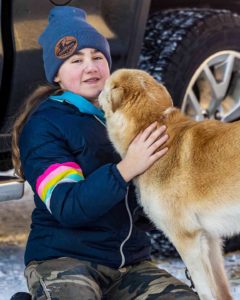Sprint Racing
... A Deeper Dive
🐾 The Bond That Drives the Team
Every successful sled team runs on more than strength and speed — it runs on trust. Mushers and their dogs share a powerful connection built through months of training, care, and shared adventure. Each command, glance, and motion on the trail reflects that partnership. Whether racing for glory or simply for the love of the run, it’s this bond between human and canine that makes the sport of sprint mushing so inspiring to watch — and even more rewarding to be a part of.
Sled Dogs ~ Built for Speed:
Sprint racing is all about speed, precision, and teamwork in the world of dog mushing. Spectators are drawn to its energy and excitement — the shorter distances often lead to breathtakingly close finishes, where every stride counts and the power of the team is undeniable.
Unlike long-distance races such as the Iditarod, sprint events are shorter bursts of intensity, typically ranging from 4 to 20 miles. These races may be held over one or several days, with teams repeating the same course to test both the dogs’ consistency and the musher’s strategic skill. Sprint teams are smaller, often made up of 3 to 14 highly conditioned dogs bred for speed and efficiency.
Behind every sled and musher is a team of remarkable canine athletes — bred for endurance, teamwork, and an unshakable love of the trail. From traditional Arctic powerhouses to modern racing mixes, these dogs embody the strength, spirit, and excitement that define the Northern Pines Sled Dog Race. Let’s meet the breeds that keep the sleds flying and the tradition alive!
🐾 Meet the Canine Athletes of Dog Mushing at the NPSDR:
🥇 Alaskan Husky – The Speed and Endurance Expert
The Alaskan Husky isn’t a registered breed but a purpose-bred athlete, perfected by generations of mushers in Alaska. Developed from Siberian Huskies, Alaskan Malamutes, and later mixed with hounds and shepherds, these dogs combine strength, stamina, and intelligence. With lean builds and incredible lung capacity, they dominate modern sled racing — built to run fast and far, even through the harshest winter trails.
❄️ Siberian Husky – The Legendary Trail Companion
Hailing from the Chukchi people of Siberia, Siberian Huskies were bred to travel long distances in subzero temperatures. They became world-famous after the 1925 Serum Run to Nome, where teams of Huskies delivered life-saving medicine through fierce blizzards. Known for their endurance, friendly nature, and striking blue eyes, Siberians embody the true spirit of traditional dog mushing.
The Alaskan Malamute, one of the oldest Arctic sled breeds, was developed by the Mahlemiut Inuit for hauling heavy freight across frozen terrain. Larger and stronger than racing dogs, Malamutes are built for power, not speed. Their thick coats, deep chests, and determined nature made them essential to early Arctic explorers — and enduring symbols of strength and loyalty.
⚡ Eurohound – The Modern Racing Mix
The Eurohound is a high-performance blend of Alaskan Husky and Pointer, bred for explosive speed and sharp agility. These dogs combine the Husky’s endurance with the Pointer’s athleticism, making them perfect for sprint and mid-distance racing. Popularized in Europe and now common in North American events, Eurohounds are sociable, intelligent, and thrive on teamwork.
🏁 Greyster – The Sprinter Supreme
A close cousin of the Eurohound, the Greyster mixes Greyhound speed with Pointer endurance. Designed for short-distance sled and dryland races, they’re sleek, muscular, and lightning-fast. Greysters love to run and excel in moderate climates where their smooth coats keep them cool while pushing for record times.
🚀 Whippet – The Little Lightning Bolt
Though less common in traditional mushing, Whippets are valued in sprint racing for their burst speed and nimbleness. Originally bred in England for racing and hunting, they’re lightweight, graceful, and fast over short distances. Some mushers cross Whippets with Huskies or Pointers to create smaller, quicker sprint teams — proof that even the smallest dogs can run with big heart.
• The Dogs Welfare Is Paramount: Responsible mushers prioritize the health and well-being of their canine athletes, ensuring proper rest, hydration, and nutrition before, during, and after races.
The Musher ~ Leader of the Pack:
The musher plays a critical role in sprint racing success. Here's what it takes to be a top competitor:
• Athleticism: Mushing requires good physical fitness. Mushers need endurance to run alongside the sled, especially on uphill sections, and strength to handle the team.
• Dog Handling Skills: Building a strong bond and trust with the dogs is essential. Mushers train their teams extensively, teaching them commands and building their confidence on the course.
• Strategic Planning: Sprint racing isn't just about raw speed. Mushers need to strategize race pacing, navigate the course effectively, and make quick decisions during the race.
• Knowledge of Breeds: Understanding the strengths and weaknesses of each dog in the team helps the musher optimize performance. Becoming a musher often involves years of experience, starting with seeking help from more experienced mushers and then working their way up to handling their own team.
Dog Mushing is a Lifestyle:
That statement highlights the key difference between dog mushing and traditional sports. Here's a breakdown of the reasons why dog mushing goes beyond just being a sport:
• Year-Round Commitment: Unlike most sports with defined seasons, dog mushing requires mushers to care for their canine athletes year-round. This includes:
◦ Training: Maintaining the dogs' fitness and sharpening their pulling skills throughout the year is crucial.
◦ Nutrition: Providing a balanced diet to keep the dogs healthy and strong is an ongoing responsibility.
◦ Veterinary Care: Regular vet checkups and preventative measures are essential for the well-being of the team.
• Bonding and Trust: In dog mushing, success hinges on the musher's relationship with the dogs. Building trust and a strong bond takes consistent effort and goes beyond just the race season.
• Lifestyle Integration: Dog mushing becomes woven into the fabric of the musher's family life. Their living situation often revolves around accommodating the dog's needs for space, training areas, and proper sheltering.

